Vegan Growth Portfolio Model results updated through June 30, 2021
We’ve updated our Vegan Growth Portfolio model results with the data through June 30, 2021.
We’ve updated our Vegan Growth Portfolio model results with the data through June 30, 2021.
May 25, 2021
Apologies for the delay in writing this draft. If the facts are in the midst of changing I prefer to hold my thoughts until I’m more confident to admit them to paper.
When markets are acting healthy the majority of our gains will come from Growth stocks with the Nasdaq Composite Index. In just this calendar year we’ve had two Sell signals on the Nasdaq. Both Sell signals had meaningful follow through which offers at least some meaningful satisfaction. But I sure would like to see a follow thru rally last for longer than a couple weeks. All in all, this creates a very choppy environment more suited to trading than intermediate termed investing.
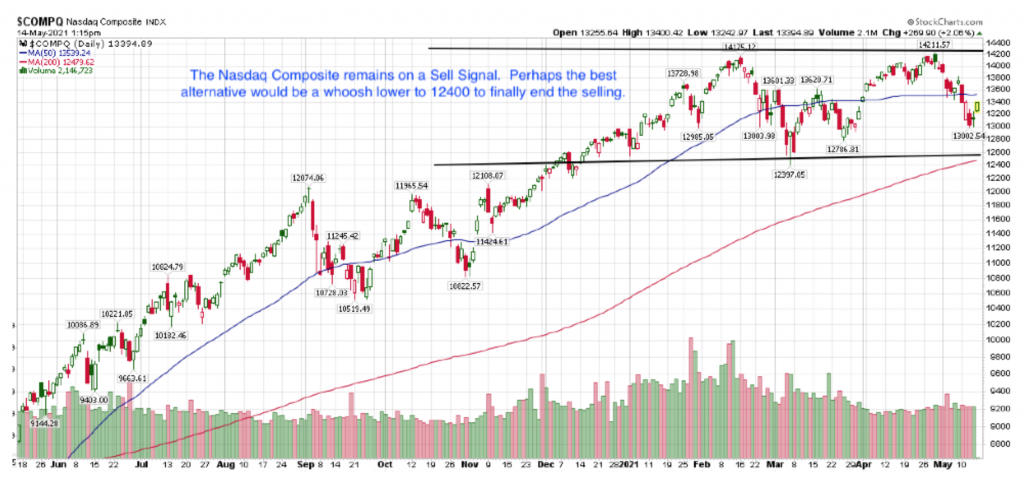
The cause for the choppy markets has been the rise in interest rates of long term bonds. The bond selloff has been precipitated by a significant boost in commodity prices and inflation plus the Federal Reserve’s current policies. The Fed’s current overly generous policies are more suitable for an economy deep in recession and not for an economy with short term GDP growth of 8%.
Rising interest rates are toxic for Growth stocks. See the 40% decline in the ARKK Etf which has been a benchmark for ultra Growth companies.
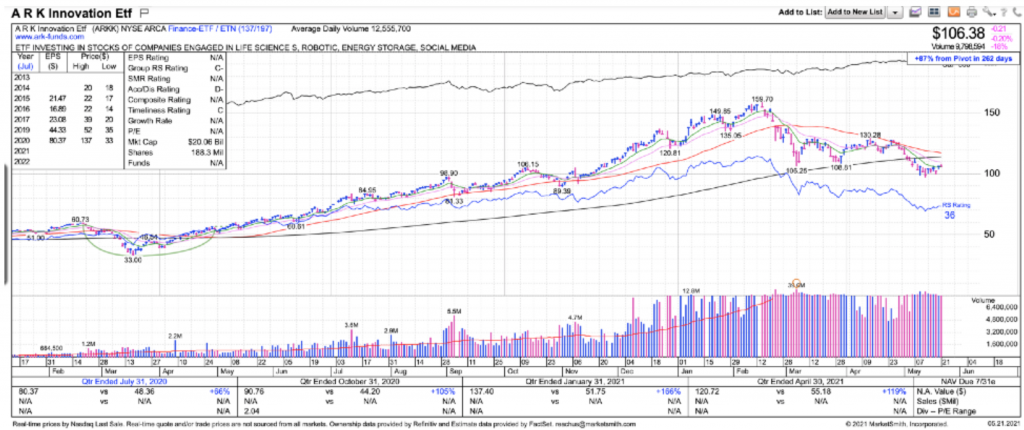
A week ago, the inflation and commodity debate appeared to hit a peak with Stanley Druckenmiller’s editorial in the Wall St. Journal and on interviews with CNBC. If you’re not familiar with Mr. Druckenmiller, he is someone worth following. Extremely well- deserved reputation and his opinions appear to have struck a nerve at the Fed.
https://www.cnbc.com/video/2021/05/11/stanley-druckenmiller-fed-policy-criticism-us-economy.html
The current Fed monetary policy as stated by Chairman Powell is to not consider raising short term interest rates for another “31 months”. As I mentioned earlier this stance is inappropriate currently and could lead to a significant long term boost in inflation a’ la 1970s.
Since Mr. Druckenmiller’s editorial two members of the Fed Board of Governors have mentioned the need to address raising short term rates this year. All markets got the message clearly and while its early- it appears long term Treasury bonds and prices have steadied, Growth stocks have halted their decline and may be in the process of turning higher.
While rising interest rates are toxic to Growth stocks, falling or steady interest rates can be a tailwind. It’s early but Growth appears to have put in a bottom and is in the early stages of moving higher.
I can’t tell you exactly why cycles tend to work more often than not. But I’ve been following NDR’s cycle research for over 20 years. As the chart shows the Month of May can be rough. Rough markets can generate a great deal of fear and rid the market of complacency. Fear is a necessary factor for markets that bottom and eventually turn and rally.
But looking out to the Fall of this year, markets could make a steep decline based on the chart below. This could coincide with the Fed pulling back from an easy money policy with accompanying bond and mortgage buying.
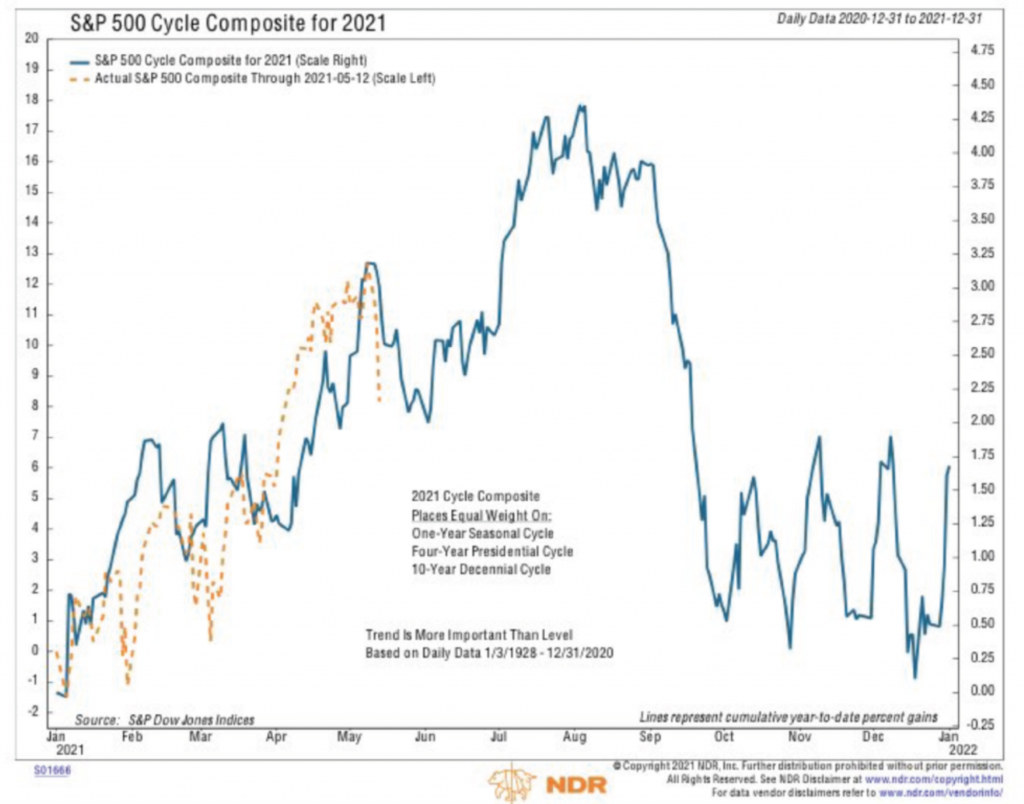
Speaking of fear and its role in investing: Fear is an inverse indicator. Investor sentiment is not accurate to a pin point degree but it is a factor on a weekly to monthly basis.
The NAAIM Exposure Index which measures stock market exposure by active money managers is a good inverse tool. I try to do the opposite of whatever their level of exposure is. High exposure is negative and low exposure is positive for stocks.
The NAAIM chart is the top section of the chart below. The members tend to be highly invested at the top and have much lower exposure near market bottom. This is human psychology and behavior repeated over and over again.
Invest up to your eyeballs when confidence is high (which means you’re a market genius) which means you’ve just experienced a good rally. At market bottoms investors are disgusted and afraid. Hence, they chase the inevitable rally.
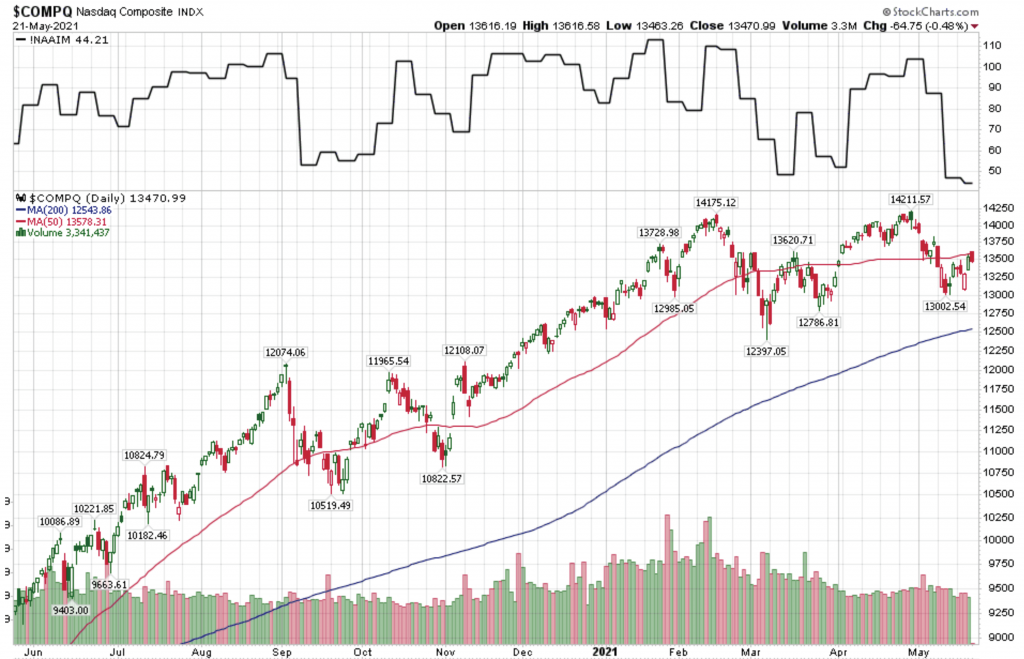
This week the NAAIM data is at 44.21. This is the lowest it’s been since March of last year.
Of course there is no assurance it won’t go lower if more market weakness occurs but its one of the primary reasons I began increasing market exposure to Growth stocks.
Is the current ramp in Inflation permanent or transitory? IMO Inflation has been with us a long time despite the official government data.
From Shadowstats I’ve posted below Inflation stats based on the 1990 method and by the 1980 method. The Fed has altered the formula for how they calculate inflation to produce a lower level. At minimum this is a conflict of interest for Social Security recipients.
Our positions in Gold, Silver and Coinbase are more of a reflection on the Fed’s debasing the $USD which will lead to inevitable problems. Druckenmiller opines that we could lose our Reserve Currency status within 15 years.
Gold and Silver are obvious choices to hedge against inflation and currency risks. Bitcoin is one as well but its so volatile that by the time you pick your groceries out at the market the price will change by checkout time.
The recent rout in Bitcoin and the inept IPO of Coinbase shares offers an opportunity. While Bitcoins cannot be counterfeited, theres no stopping someone from creating a completely new coin day after day.
By owning Coinbase we don’t need to care about whichever coin is hot this minute. We can own the bitcoin exchange. This is back to owning the hardware store in the 19th century gold mining days rather than mining for the gold.
This morning 5/24 Goldman Sachs upgraded Coinbase with this following note:
Coinbase initiated with a Buy at Goldman Sachs MAY 24, 2021 ‘ 04:56 EDT
Goldman Sachs analyst Will Nance initiated coverage of Coinbase Global with a Buy rating and $306 price target, which represents 36% upside from current share levels. The company offers leverage to an ecosystem that has seen “strong growth” driven by increasing adoption of digital currencies, a leading consumer platform with “strong” customer acquisition trends, an “attractive business model that thrives on elevated cryptocurrency volatility,” and “significant opportunities” to add additional features and capabilities, Nance tells investors in a research note. The analyst sees “significant white space” for Coinbase’s new initiatives to drive more stable and recurring revenue streams.
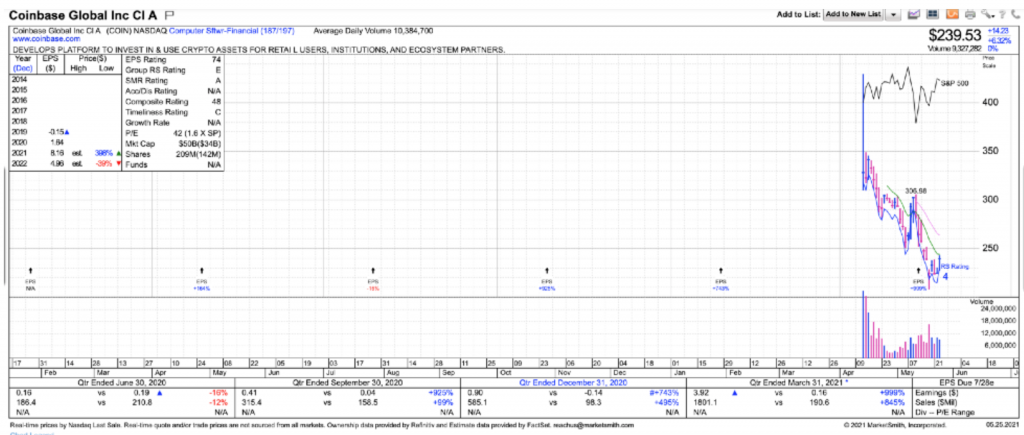
Our average cost for Coinbase is approximately $234.
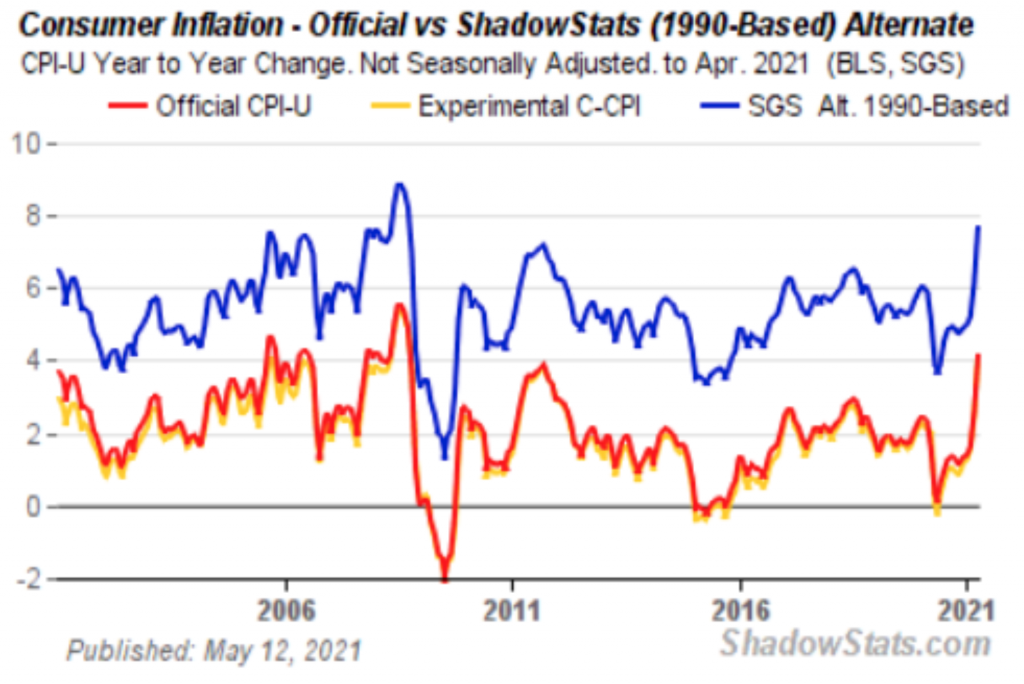
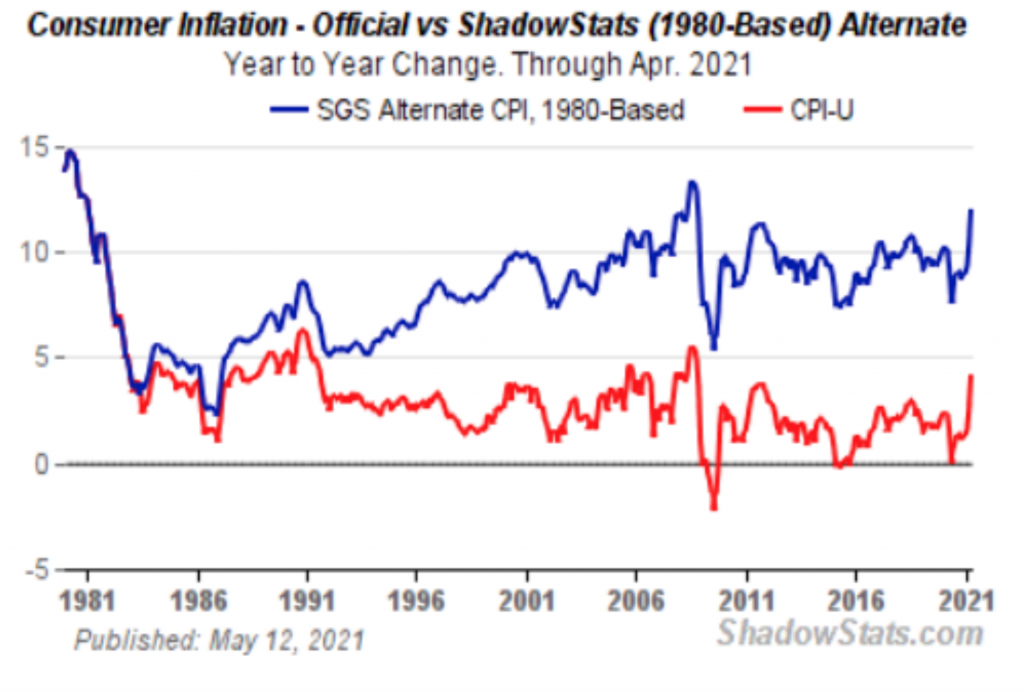
The CRB Index below is produced by the Commodity Research Bureau and is a composite and is a reflection of price trends in commodity markets. Just another way of looking at rising inflation.
One year ago it was 131.62 and stands at 200.87 today.
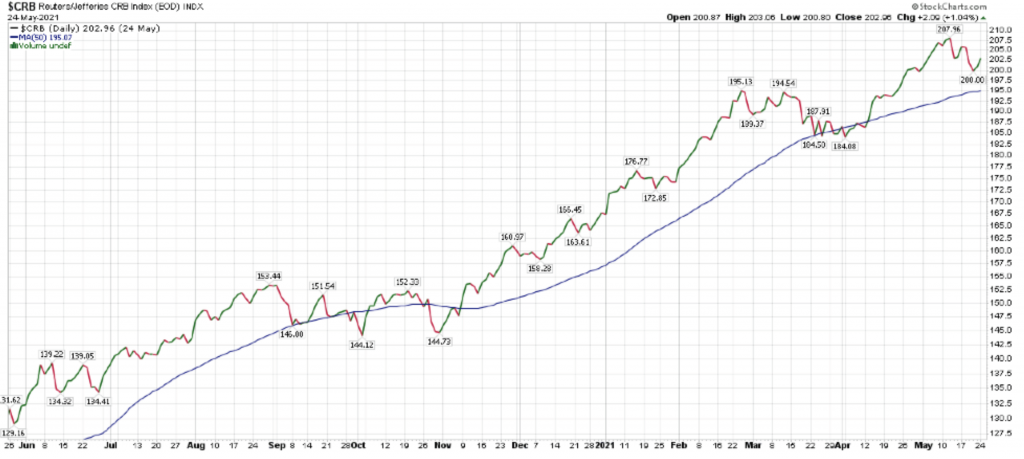
Stanley Druckenmiller’s Op-Ed in the Wall St. Journal titled “The Fed Is Playing With Fire”
The American economy is back to prerecession levels of gross domestic product and the unemployment rate has recovered 70% of the initial pandemic hit in only six months, four times as fast as in a typical recession. Normally at this stage of a recovery, the Fed would be planning its first rate hike. This time the Fed is telling markets that the first hike will happen in 32 months, 2½ years later than normal. In addition, the Fed continues to buy $40 billion a month in mortgages even as housing is clearly running out of supply. And the central bank still isn’t even thinking about ending $120 billion a month of bond purchases.
Not only is the recovery happening at record speed, excesses of fiscal policy are already visible. Consumers are spending like never before, construction is
booming, and labor shortages are ubiquitous, thanks to direct government transfers. Two-thirds of all relief checks were sent after the vaccines were proved effective and the recovery was accelerating. Opportunistic politicians didn’t let the pandemic go to waste. Especially after the Trump years, Congress has decided to satisfy its long list of unmet desires.
Investors should anticipate the Fed shifting from an overly accommodative policy to one of more restraint. Until recently this was not a topic of public conversation by the Fed, but it is now.
By no means is this the end of the world for stocks. It just means there is likely to be a sizable pullback when the Fed shifts gear. I would expect this to be in the vicinity of November of this year. But markets will begin to adjust to this change before then.
The NDR cycle chart is potentially an accurate time line of when and what to expect later this year. To be frank, I would really like to have a good sell-off, which I’d hope to avoid. As this would be “the Pause that refreshes”.
In the meantime we may be moving past peak-inflation which is why Treasury bonds prices have turned up. In turn, this is causing Growth stocks to rally.
A normalization of interest rates could likely mean a return to the value of Active Management. Active managers with effective systems can potentially avoid sharp sell-offs that would leave Index investors exposed.
Thank you,
Brad Pappas
May 25, 2021
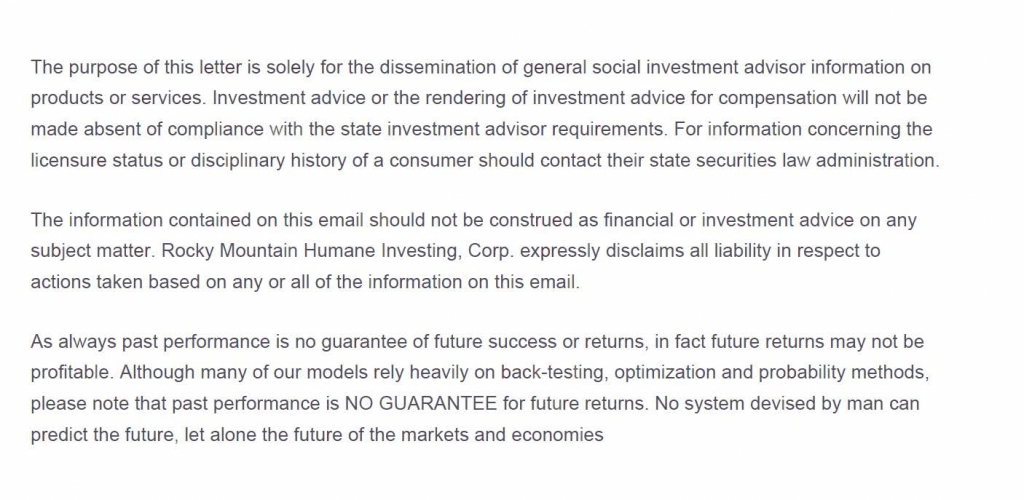
March 8, 2021
We are in the midst of the largest rotation from Growth stocks to Value stocks in the past 21 years. You’d have to go back to the Tech Bubble of 2000 to find anything like the present situation. Stocks that were formerly beloved like Tesla falling from its high of $900 a month ago to $539 today. But beneath the surface there is significant strength.
The trigger for this has been the rise in interest rates that continues to accelerate. No doubt the eventual demise of Covid is the tail that wags the bond market which is wagging the stock market. The 10-year Treasury yield has rising from 0.95% to 1.62% since the start of the year. This increase may not seem like much but its very important when it comes to stock and market valuations.
When interest rates were under 1% (which means the risk-free rate of return) high flying Growth stocks were the place to be since valuations meant almost nothing. Once the risk free rate of return began to rise (and we have no idea how high it will go) it meant that the High Growth sector would no longer be compared to extremely low interest rates. Higher risk free rates brings down the value of every investment vehicle including real estate and businesses.
Growth stocks frequently have only minuscule or no earnings whatsoever.
Those kinds of stocks can implode since their valuations are overextended. This combined with the reckless buying by the ARK funds has created an extremely volatile situation for Growth stocks.
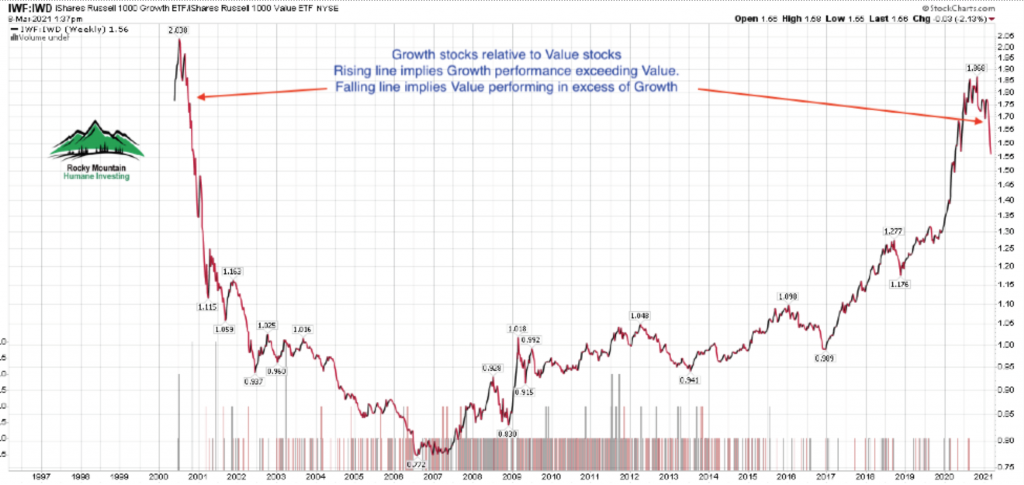
Plus, Growth performance relative to Value became the most extreme since 2000, so something bad was bound to happen. And, mean reversion is brutal. If an investor had not lived and traded through 2000-2006 they would have no idea how bad it can get. Psychologically, new investors have a hard time understanding why a great Growth stock can suddenly become toxic. In those cases small losses probably become big ones.
The ARK shipwreck
Case in point: The ARKK Exchange Traded Fund run by the star of this era Cathie Woods. Just over a year ago the ARKK ETF had $10 Billion in assets. As of a month ago ARKK managed $60 Billion. Almost every investment manager or hedge fund keeps a very tight lip on what holdings they own. ARKK actually publishes a daily list of what she’s buying or selling. This is extremely
dangerous because ARKK purchased such a high percentage of some companies that she cannot liquidate her shares in a reasonable time.
The ARKK fund presents a systemic risk to Growth stocks. When ARKK’s assets were growing exponentially Cathie Woods and ARKK continued to buy and buy to absorb the incoming cash. Thus driving up prices exponentially as well.
The risk to ARKK is that the liquidation phase as investors withdraw their capital. Clients withdraw assets as ARKK shares decline, thus ARKK is forced into selling its holdings which creates more losses. Open ended ETF’s like ARKK cannot put a hold on client withdrawals the way a hedge fund can.
To compound the issue, in Japan a financial firm was formed to mirror the trades of ARKK for their Asian clients.
ARKK also has other funds in its quiver. For just March 6th: ARKQ had -$96mm withdrawal, ARKW -$197mm withdrawal, ARKF -$94mm withdrawal, ARKG -$183mm withdrawal. Oddly ARKK had +$48mm inflow. Net Withdrawal for March 6th was -$524mm withdrawal.
So if another financial firm were managing their Growth portfolio responsibly, the unholy cycle of ARKK spreads to other firms as well. These other firms can get sucked into the vortex of forced selling of Growth stocks.
Growth must be avoided until this business with ARK is over. Fortunately for us, ARK never invested in Value at all.
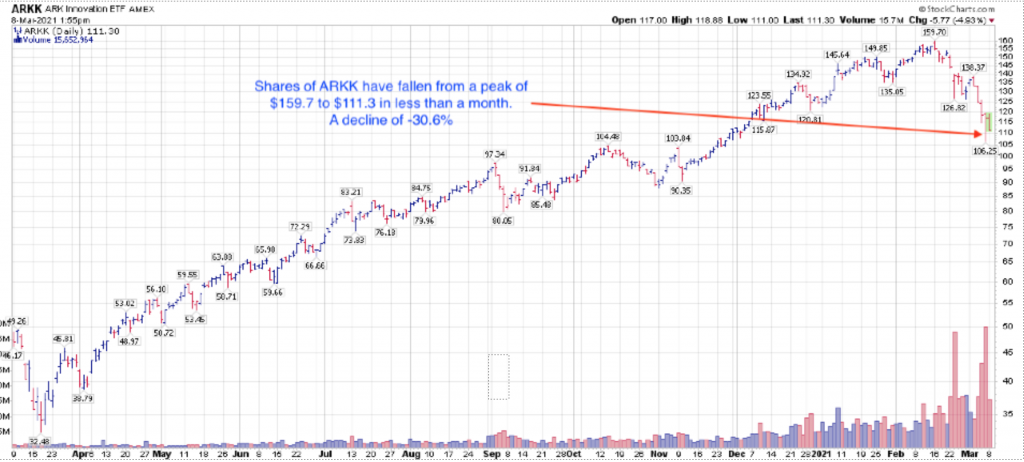
So at present my proprietary market models are on a Sell for the Nasdaq and for the Growth sector of the S&P 500 and Russell 1000 IWF.
And because we have a bifurcated market I have a Strong Buy for the IWD or Russell 1000 Value and S&P 500 Value.
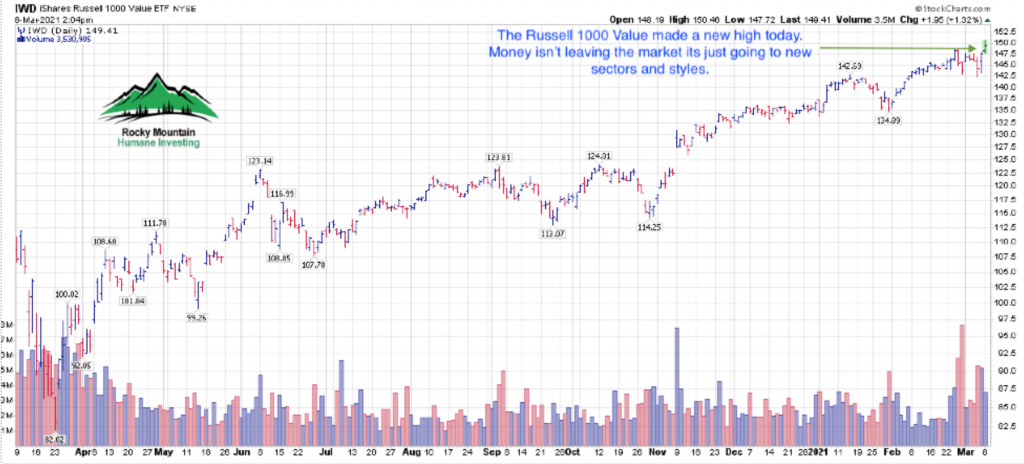

Present Strategy: I really don’t want to say that Growth stocks are dead money for a long length of time but it’s very likely. Growth is much less attractive than the “Epicenter” stocks.
Stocks have bifurcated to the point where a broad based index thats naturally biased to Growth stocks will give me a Sell signal. However once I switch to Value indices I see a very strong group of companies worthy of investment.
I’ve been expecting a mean reversion from Growth to Value for close to a year. It’s happening in a big way and I expect it to continue.
Money is not necessarily leaving the stock market when it sells off, they are rotating. Large investors are rotating from high Growth to Value. Value is the place to be since it benefits from higher interest rates and the retreat of Covid from our lifestyle.
Data is strongly suggesting that Covid daily cases to drop by 50% by early April 2021. And, fall close to zero by May 2021. This is why the “Epicenter” stocks are so attractive. You and I and everyone else is going to fly, go on vacation and visit restaurants and malls once again.
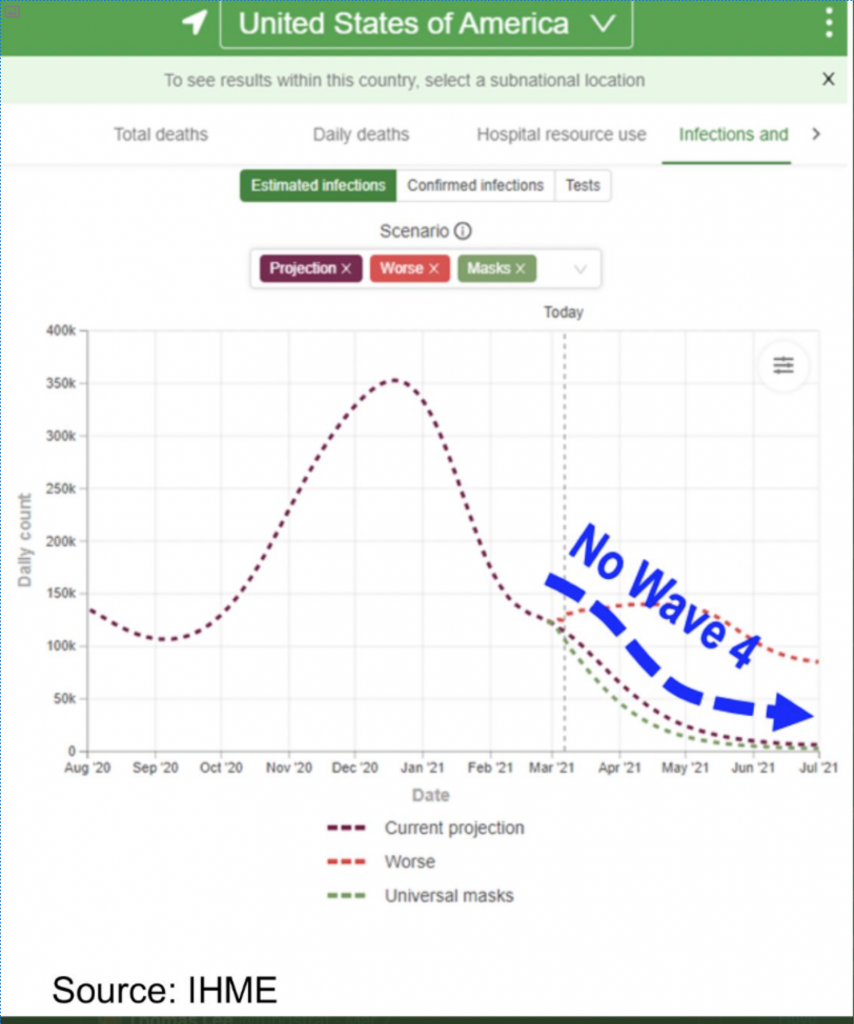
Be Well. Be Kind.
Brad Pappas
March 8, 2021
Long all stocks mentioned.

We’ve updated our Vegan Growth Portfolio model results with the data through March 1, 2021.
We’ve updated our Vegan Growth Portfolio model results with the data through Jan 30, 2021.
Bring On The Sell-off!
1/30/2021
Quick Summary: Two weeks ago I began raising cash in accounts because investor sentiment was too hot and market breadth was eroding. Too many traders playing with borrowed money “margin”. It appears we’re seeing forced liquidations as we’re down another 600 pts. We don’t need a formal Sell signal to occur when our Stop-Loss orders get triggered en masse. The combination of too much speculative trading in margin combined with future market scrutiny by regulators may be causing institutional investors exit by the side door.
We presently have just two stellar holdings: Sivergate Financial and Innovative Industrial Properties. In both cases we have such a large profit cushion and they continue to show relative strength in weak market that taking a profit here may not be the wisest of choices.
The NAAIM Index (naaim.org) publishes a survey of active managers like RMHI to find out their current market exposure. Last week’s reading of 112.93 is rarely seen and means that not only are active managers over 100% invested but they’re adding leverage/margin. As the chart shows these kinds of readings are common near intermediate term market peaks.
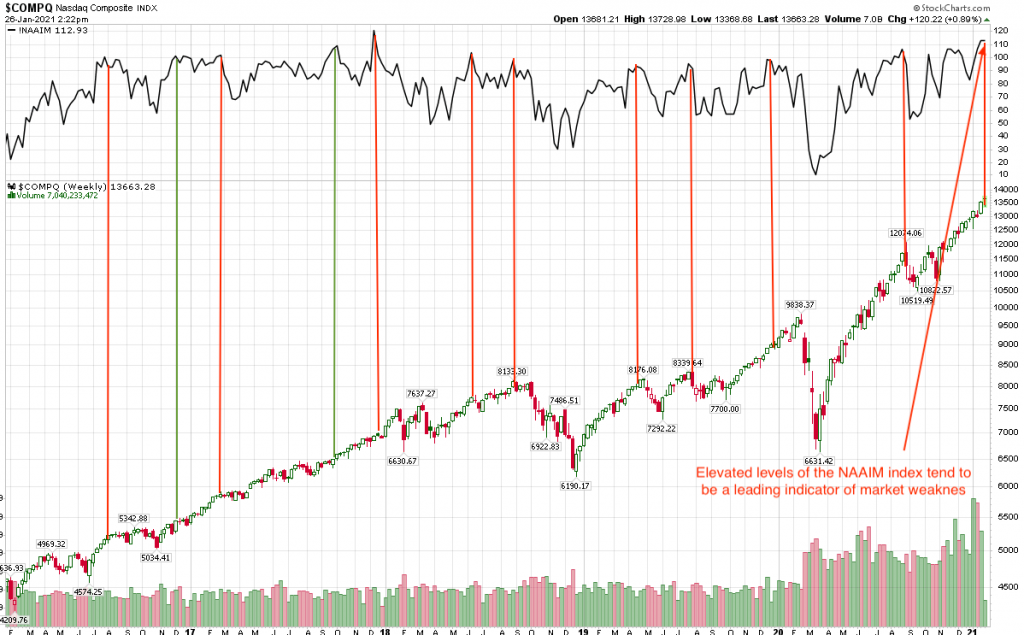
For more than a month I’ve been watching the grotesque level of mindless speculation that has exploded with Gamestop or GME. The media has created an image of the small time investor having revenge upon the evil billionaire hedge fund managers, akin to David vs. Goliath. Nothing could be farther from the truth.
The business of Gamestop has not changed. They have an eroding business model where gamers no longer need to go to a store to buy games since they can download them from home or where ever.
Short selling is not new and serves a valuable service since short sellers seek out and punish fraudulent companies.see Enron, Worldcom, Conseco, Baldwin United, etc. This provides a checks and balances alternative to the always bullish media market hype.. In addition, most stock market rallies begin when short sellers start to buy stock back to lock in profits which creates the initial market bounce.
What is new is the interest rate policy of the Federal Reserve manipulating interest rates to near 0%. Near zero interest rates crushes savers who used to rely on CD’s and other interest bearing instruments. These investors are then forced into risk assets such as stocks.
Near 0% rates coupled with substantial stimulus money, bored people, time and smart phones on hand have created a toxic mix of speculation. Trading in GME is a textbook Greater Fool Theory. The fool who pays $337 for GME shares needs an even bigger nitwit to sell to at a profit.
Short sellers who were short the shares of GME are then forced to buy GME shares to cut their losses. Thus creating a whirlwind of self fulfilling behavior.
I’m fairly sure that at the root of this is not the little guy small investor but other big players, They’ve created a modern day Ponzi Scheme. Big players who made early bets on GME back in September when it was trading under $10 are the real beneficiaries.
The tactic of using Social Media to channel investor behavior is new and probably here to stay. Just this morning Elon Musk tweeted that he like Bitcoin which sent our shares of Silvergate to a new high of $102.
It’s laughable to me that the politicians and regulators who were asleep now want “investigate” and show concern for the very environment they created.
But all of this kind of behavior is really nothing new. As Jesse Livermore said over 100 years ago: There is never anything new in the stock market. Human behavior never changes. It always shifts from fear to greed and back to fear again.
However, the levels of speculation we’re witnessing are associated with market peaks. Less reputable brokers like Robinhood run a real risk of becoming insolvent due to the probability of unsecured debits in client accounts. In other words traders who are borrowing money to buy GME can not just lose the equity in their accounts but have the value go into the negative.
Or, as I witnessed last night Robinhood forced traders out of their holdings without their knowledge or consent at the the low price of the day? Guaranteeing losses? Bring on the lawyers and class action suits.
In my experience this period of market history is fascinating and eventually probably will lead to tremendous losses. Investors of all kinds tend to act in a herd mentality and when the herd decides to start selling, my guess is the market could easily decline by 20% or more.
If we’re lucky.
I hope we do decline. We are prepared for it with an extremely high amount of cash on hand. Smaller accounts are 100% cash.
I would love nothing more that be presented with a new Bull Market cycle that would reveal itself after a severe market decline.
Risk Control
I’d like to spend some time on how RMHI emphasizes risk control and the methods used. Clients never see this data. If you access your account at Schwab or from your account statements you won’t be able to find it. I spend most of my days monitoring a dashboard of potential open trades that are stop loss orders.
A Stop Loss order is an order that I have placed at Schwab on your behalf to protect your principal. At the time of purchase I’ll add a Stop Loss Order set between 4% to 5% below cost. This is all I’m willing to lose and it means that losses will be small. But it also means that trading is going to be more frequent. There’s no perfect formula but I find that 4% is very effective despite more activity.
When we buy a stock and it declines from the initial prices to a loss between 4% or 5% the shares will automatically be sold. It’s not a guarantee that the sale price will be exactly at 4% since the next trade price could be lower.
Should the stock price rise the Stop Loss order rises accordingly. If the shares rise 7% or more the Stop Loss Order is adjusted to the cost of the shares. A winning trade should never be allowed to be a loser.
One way I wanted to improve performance was to find ways to increase our Profit to Loss ratio. A 2-1 ratio means we’re averaging a gain of $2 for every $1 we lose. A P/L ratio of 2-1 is good but ours had fallen from that level to 1.6 to 1 which is unacceptable.
To improve the P/L ratio it means a complete reevaluation of how stocks are selected and an effective formula for how they are sold. Its been my observation that the good trades work almost immediately, usually within a day or two since the purchase. Once the trade proves itself I’ll add on more shares which is called “pyramiding”.
But in a favorable market a 4% stop loss is very effective and if the order is “stopped out” meaning it was executed, we just move on to another stock with favorable behavior.
Cutting losses short also means we don’t dwell on them for weeks which could cause us to miss out on other potential winners.
The key is to identify which stocks could be the significant winners and to let them run for as long as they can. Stocks like Silvergate are rare and in most cases its best to sell a stock if it reaches a gain in the 20% range.
But even if a stock only rises by 10% when the gain is taken its still a 2-1 win loss ratio if a 5% stop loss is used.
Last week I decided to calculate what our Profit/Loss ratio has been since I made the changes. I used the model account I have to collective2.com. Its the fairest way to measure since it copies our own trading in an objective way.
Since November and up to this week our Profit and Loss ratio had improved to 5-1, which made me very happy.
However, the P/L ratio of 5-1 does NOT include our existing holdings, only those shares that were sold. Since the sale of 1/3 of our Silvergate shares this week our cost basis rose from approximately $28 to $35. Meaning the gain from $35 to the present price of $94 has not been taken into account. The same holds true for Innovative Properties.
The bottom line for the use of Stop Loss orders and in coordination with proprietary market buy and sell signals is to smooth out the growth of equity in client accounts.
We will not always be invested but fully invested only when the odds are in our favor.
Be Well. Be Kind.
Brad Pappas
January 21, 2021
Long all stocks mentioned.
